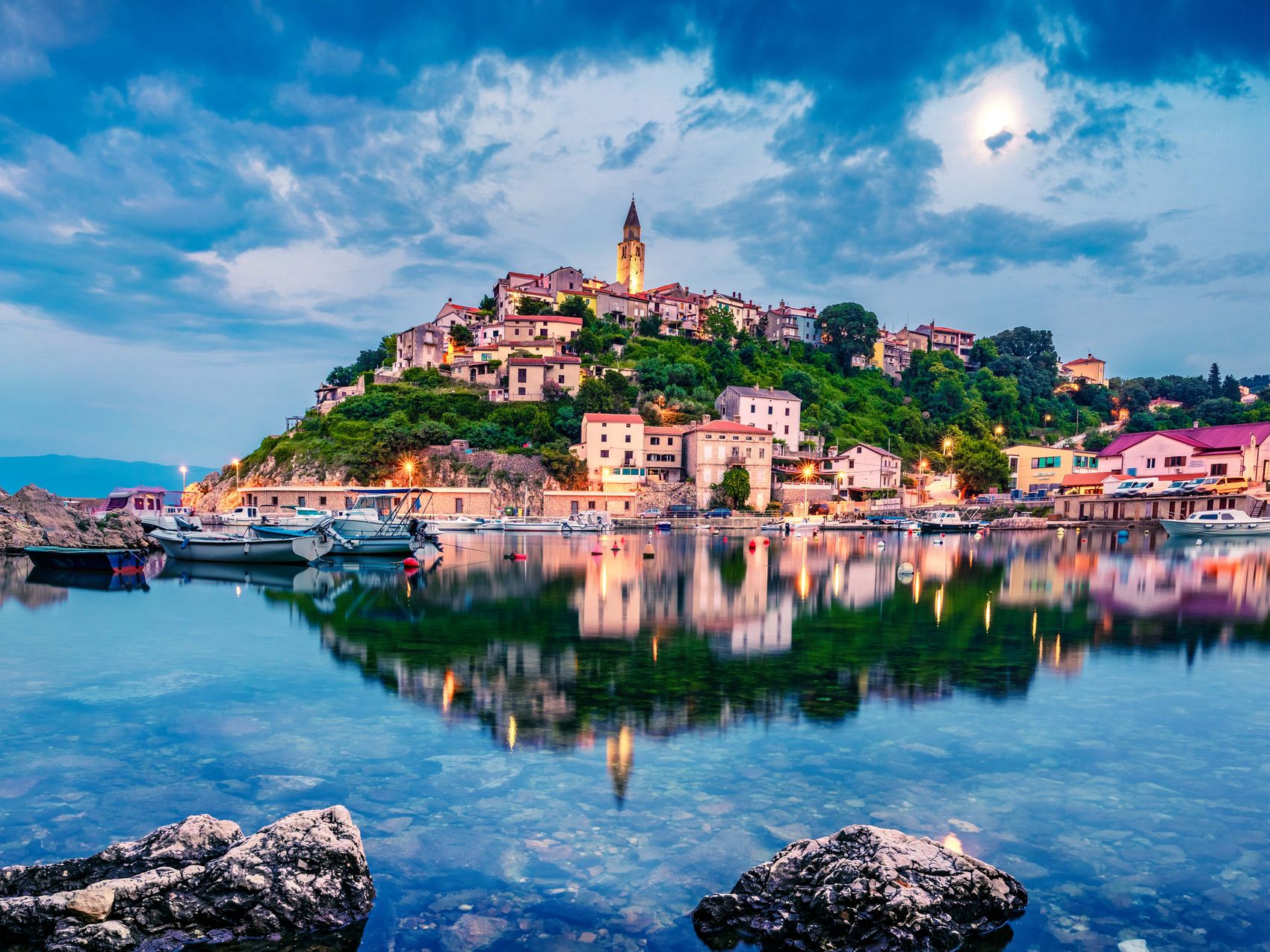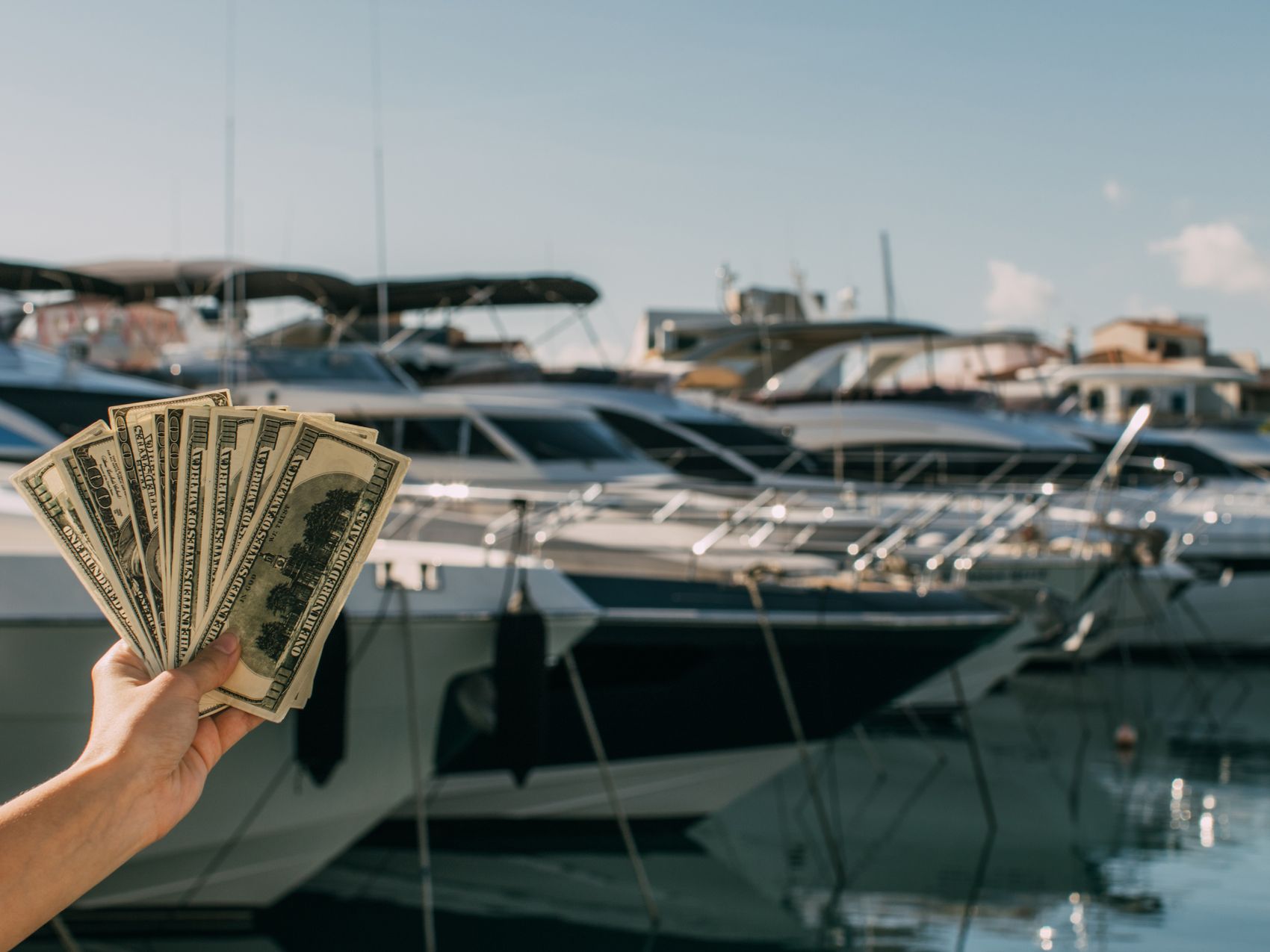Planning a sailing holiday in Croatia in 2025? This guide offers up-to-date tips and insights for sailors, from new anchoring regulations to local skipper advice on hidden bays. We’ll also cover typical costs, must-see sailing regions, and where to find more detailed itineraries and tips. Read on for a comprehensive, sailor-friendly overview of cruising the Croatian Adriatic this year.
New Croatian Anchoring Laws in 2025
Croatia has introduced important new maritime safety regulations in 2025 that affect how and where you can sail and anchor. These rules are aimed at increasing safety, but also impose some restrictions to be aware of:
-
Anchoring Restrictions: Anchoring too close to certain swimming spots is now explicitly prohibited. Dropping anchor within 150 m of a “natural bathing area” (essentially, an unregulated beach or swimming cove) is banned. The challenge here is that the natural bathing area isn’t clearly defined – Croatians swim off all sorts of rocky coves and little bays, not just official beaches. This rule could put many small, cosy coves off-limits if interpreted strictly, since in narrow bays you simply can’t get 150 m away from every shore. Authorities are expected to clarify this, but for now, be prepared that some harbours or bays may enforce no-anchoring zones near popular swim areas.
-
Shoreline Mooring: A traditional practice in Croatia is to anchor in a bay and take a long line to shore (to a rock or tree) to prevent swinging. Under the new law, you cannot secure a boat to shore if any part of the boat would end up more than 50 m from the shore. In simpler terms, you’re no longer allowed to anchor far out in a cove and run very long shorelines back – the boat must stay fairly close to the shore if tied off. Also, any lines or chains must not obstruct other vessels’ passage (no more spider-webbing across small bays with multiple lines!). This rule aims to keep access open for everyone.

These changes mean sailors need to plan a bit more. Thanks to shorter lines, avoiding swimmers or other boats is easier. Expect increased enforcement of distance rules (especially for speedboats/jet skis near beaches). Hundreds of tiny anchorages could technically be affected by the 150 m rule, but how strictly it’s enforced remains to be seen. It’s a good idea to ask local authorities or check notices (NtM) for any specific bays with new anchoring prohibitions. When in doubt, use marina moorings or official anchorage fields to stay compliant. Safety is the goal, and with a little flexibility, you can still enjoy Croatia’s beautiful coves while following the new guidelines.
Local Anchorage Tips from Jasmin

One of the best ways to discover Croatia’s hidden gem anchorages is through local knowledge. Our Croatian skipper, Jasmin Jaklin, has shared insider tips on some of his favourite bays. Below, we detail six notable anchorages – what to expect in terms of wind protection, anchoring technique, and general recommendations for each:
1. Taršće (Hvar Island, Pakleni Archipelago)
Taršće (on Sv. Klement island just off Hvar town) is a picturesque cove with turquoise water and a sandy bottom. It’s a popular day-stop for tour boats and yachties, so space can be tight.
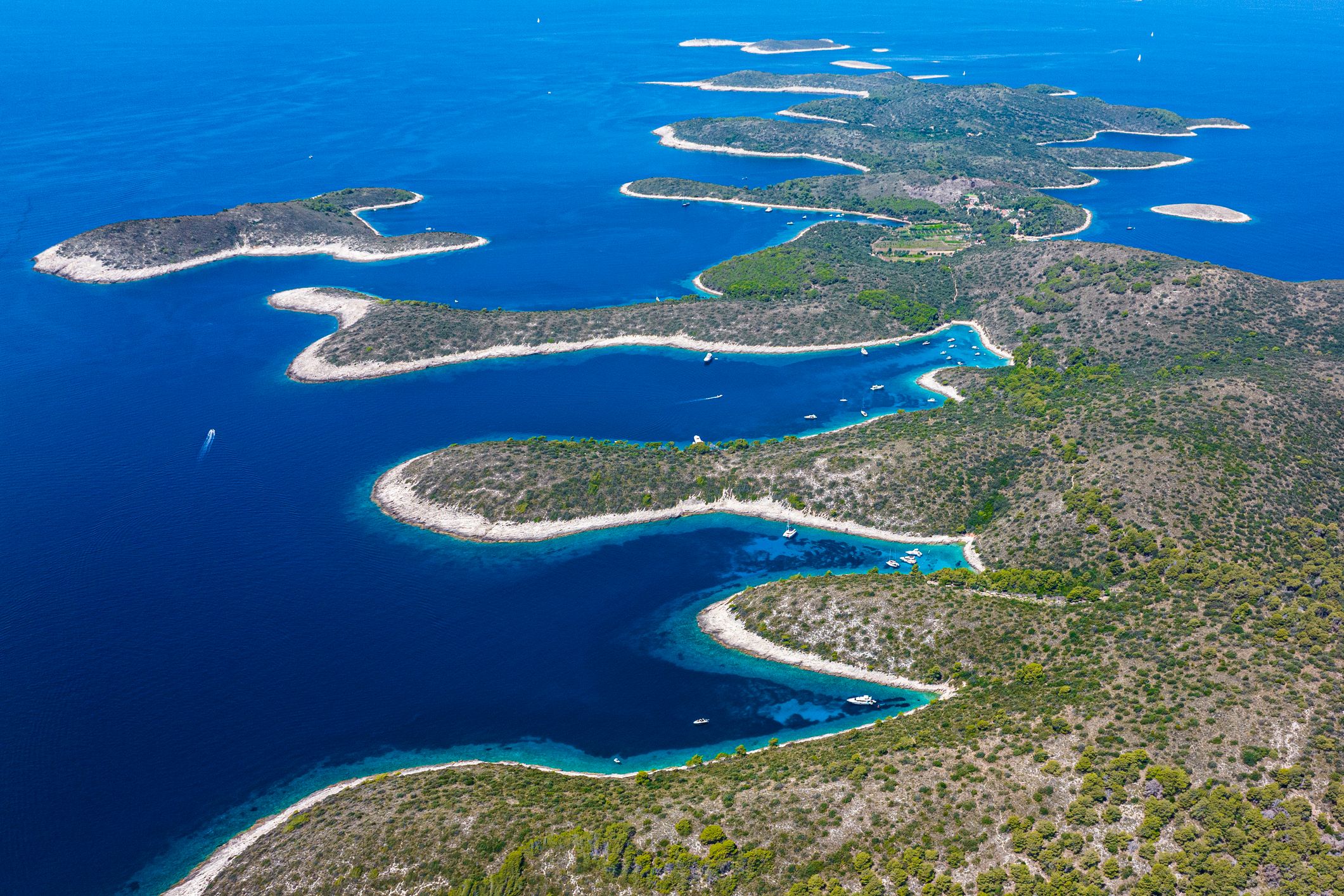
Holding: Good in sand (with some patches of seagrass) – your anchor should grip well.
Protection: The bay is well-protected from most winds, especially if you tuck in by the western shore, which buffers the afternoon westerly breeze. However, it lies open to southerly winds, so avoid Taršće if a strong jugo (south wind) is forecast.
Anchoring tips: It’s highly recommended to use shorelines here. Drop your anchor in 5–10 m, then take a stern line to a rock or tree. This not only prevents swinging in a tight anchorage but is practically necessary given the number of boats that pack in (especially in July–August). Arrive early in peak season to snag a good spot – by late afternoon, most day-trip boats leave, and you can reposition for an overnight stay in greater peace. There are no shops in the bay, but you can call over a roaming provisions boat for fresh bread or fruit (expect a bit of markup). Also, note that anchoring fees may be collected in season (some nearby Pakleni bays have private buoys or fees), but Taršće itself currently remains free if you anchor.
2. Modri Bok (Kornati Islands)
Modri Bok is a beautiful bay on the west side of Kornat Island in the Kornati National Park. True to its name (“Blue Bay”), the water here is a dazzling blue against stark rocky hills.
Protection: The bay is well protected from all winds except those from the southwest. In practice, that means it’s safe in the prevailing summer NW–NE winds and the bora, but a strong SW or jugo could send swell into this cove.
Anchoring: Depths range ~2–12 m with a sandy seabed that provides excellent holding. No mooring buoys here – you’ll be anchoring on your own gear. Given the ample sand, your anchor should hold well; just avoid the few rocky patches. There are no facilities (no village or jetty in Modri Bok), which is part of its untouched charm. The nearest konoba (restaurant) is about a mile away in Vrulje bay if you’re looking to go ashore for a meal.
Tips: Because Modri Bok lies inside Kornati National Park, you’ll need a valid park ticket to stay here. Park rangers do patrol and will check permits (it’s cheaper to buy your Kornati permit online or at a marina in advance than on-site). On a calm night with clear skies, Modri Bok is magical – minimal light pollution, just a blanket of stars and the distant hum of nature.
3. Lovište (Pelješac Peninsula)
Lovište is a broad bay at the very tip of the Pelješac Peninsula (northwest end), beloved as a safe anchorage and overnight stop. It’s known as one of Pelješac’s best anchoring spots – essentially a natural harbour.
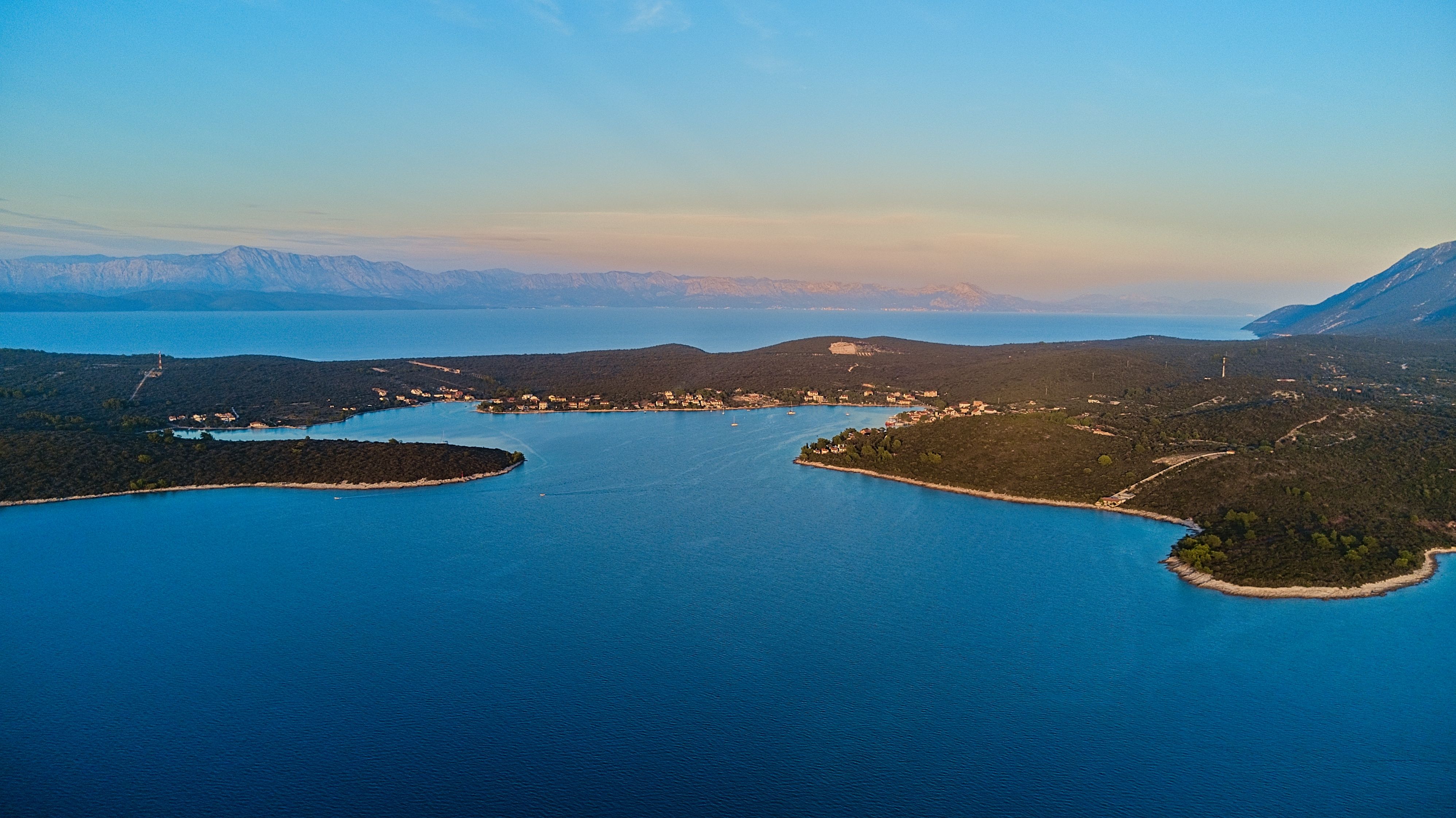
Protection: The bay is mostly surrounded by low hills and offers good shelter from prevailing winds (the typical NW Maestral and westerlies). The NW corner of Lovište bay, in particular, is the most protected spot to drop anchor, as it tucks you away from any swell that might sneak in the entrance. Be cautious if a strong south or southeast wind is forecast – Lovište is somewhat open to the south, and a jugo can send waves into the bay (though true gales from the south are not common in summer).
Anchoring: The preferred anchorage is in ~5–7 m depth on the bottom of sand and mud that provides excellent holding. In summer, you’ll often find around 20 mooring buoys laid in parts of Lovište bay, which visiting yachts can use for a fee. These buoys (managed by the local konobas or town) save you the trouble of anchoring and offer peace of mind with regard to swinging room. If you opt to anchor instead, note that during high season local officials might charge a small anchoring fee anyway for overnight stays (approximately equivalent to mooring buoy cost).
Facilities: Lovište village is a small, relaxed hamlet with a few restaurants, cafes, and a market. You can dinghy to the village pier or beach. Many sailors love Konoba Barsa in Lovište for its fresh fish. Overall, this bay is a gem – a quiet contrast to busy Hvar – where you can enjoy a gorgeous sunset and a secure night’s sleep.
TIP: Want to know how to anchor properly? Jasmin will tell you how to do it stress-free
4. Maračol (Unije Island, Kvarner Gulf)
Maračol is a deep, secluded bay on the southeast side of Unije Island, in the Kvarner region. For those sailing between Istria/Kvarner and Dalmatia, Unije’s Maračol offers a perfect midway anchorage.
Moorings & Holding: You won’t be anchoring here in the traditional sense, because Maračol has about 50 permanent mooring buoys installed. The moorings are very secure – each buoy is anchored by multiple concrete blocks, and you tie up with bow and stern lines (a small local boatman may assist, or instructions are sometimes on the buoy). This system holds boats safely even in stronger winds.
Protection: Maračol is well enclosed and calm in most conditions, but it is exposed to strong winds from the southeast. If a heavy jugo is expected, give Maračol a miss (or be ready for a bumpy night) as waves can funnel in from that direction. In all other wind conditions (NW bura, westerlies, etc.), the bay is nicely sheltered by Unije’s hills.
Amenities: The bay itself is uninhabited (just pine trees and chirping cicadas). There’s a small pier where you can land your dinghy. From there, it’s about a 15–20 minute walk across the island to Unije village. In the village, you’ll find a couple of konobas (restaurants), a grocery store, and a post office – enough for basic provisioning or a meal ashore. Some mooring fee collectors offer a tractor shuttle for crew who don’t want to trek on foot.
Note: The mooring fee is payable in cash (around €30-40 for a 12 m yacht, varying by season). Given the tranquillity and sunset views here, most find it well worth it. Maračol is a nature-lover’s anchorage – expect very clear water (great for an evening swim off the boat) and almost total silence at night.
5. Sakarun (Dugi Otok)
Sakarun (often spelt Saharun) is a famous bay on Dugi Otok island, known for its white-sand beach and vivid turquoise shallows that rival the Caribbean. It’s a must-visit if you cruise the Zadar region, though in high season it can be busy.
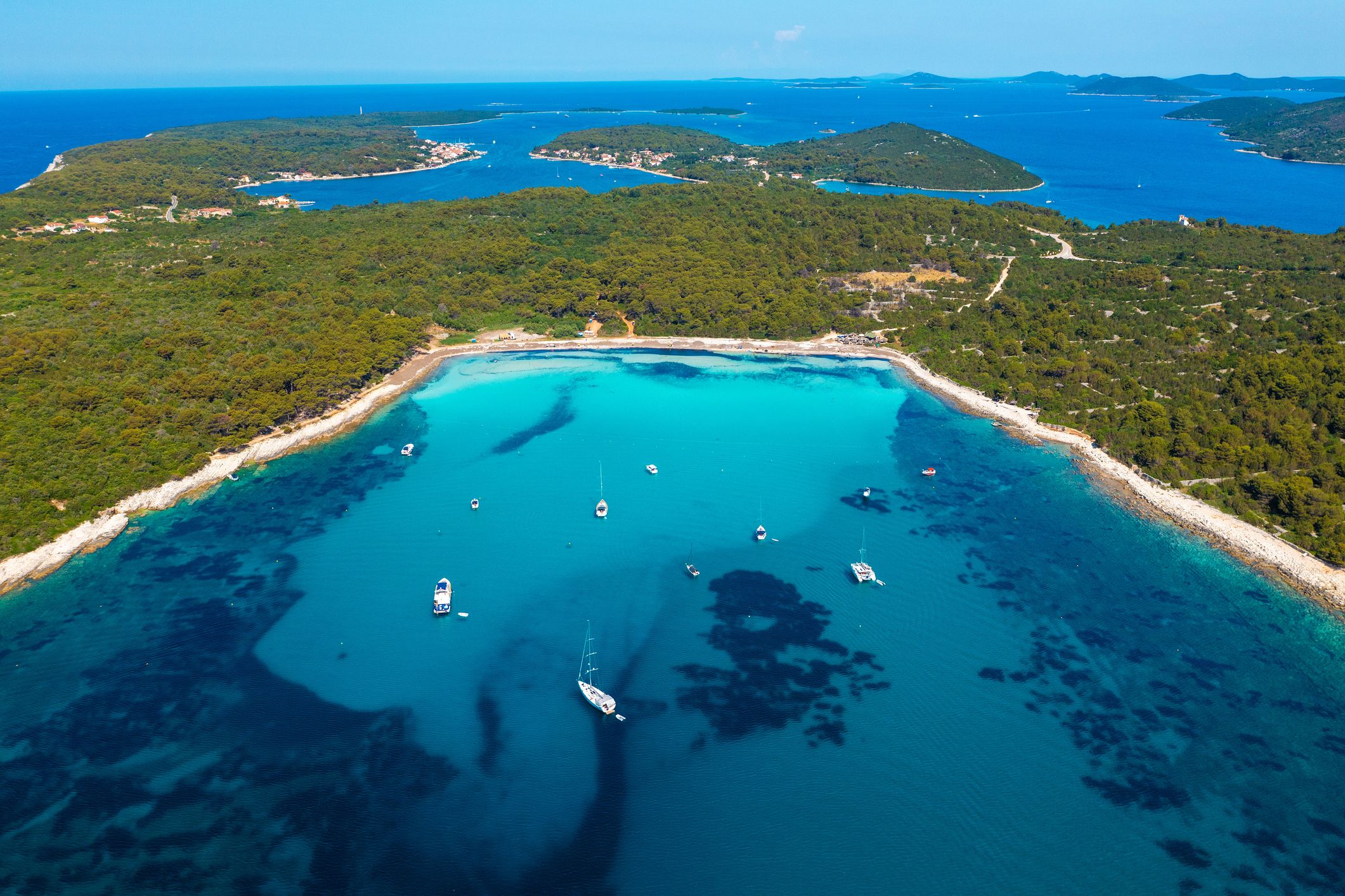
Anchoring/Mooring: In recent years, to protect the seabed, almost the entire bay has been filled with mooring buoys, and free anchoring space is very limited. You’ll find around 60 buoys here, typically at a rate of a few euros per metre of your boat’s length. Picking up a buoy is the way to go (anchoring is officially discouraged or restricted within the buoy field). The moorings are in sand patches of 5–10 m depth, and they hold well.
Protection: Sakarun is large and open to the northwest, so it’s well protected from bura (NE) and southerly winds, but a strong NW wind or swell can make it uncomfortable. In summer, the typical afternoon NW breeze might send a light chop in, but generally overnight it calms down. The big caution is southerly Jugo winds – if a south wind picks up, Sakarun actually loses its protection (since the bay’s entrance faces NW, a south wind doesn’t directly hit the bay, but jugo swells wrap around Dugi Otok). In fact, local advice is that when jugo blows, head to the nearby Pantera Bay on the opposite side of the island, which is safer in south winds.
On Shore: Sakarun’s beach is backed by pine trees and has two small seasonal beach bars (great for a cocktail or ice cream in the afternoon). There are no villages or shops right at the bay – the nearest town (Božava) is a few kilometres away (in summer, a little tourist train runs from Božava to the beach). This bay is part of a marine reserve area, so there may be a fee for the buoy (around 40-60€ for a 12 m boat). Despite the cost and popularity, an overnight here is magical – by evening, most day-trippers leave and you’ll have the glowing plankton and starlight largely to yourself.
6. Stončica (Vis Island)
Stončica is a lovely anchorage on the northeast tip of Vis Island, distinguishable by its historic lighthouse on the point. The bay is long, narrow, and reaches deep inland, ending in a shallow sandy beach.
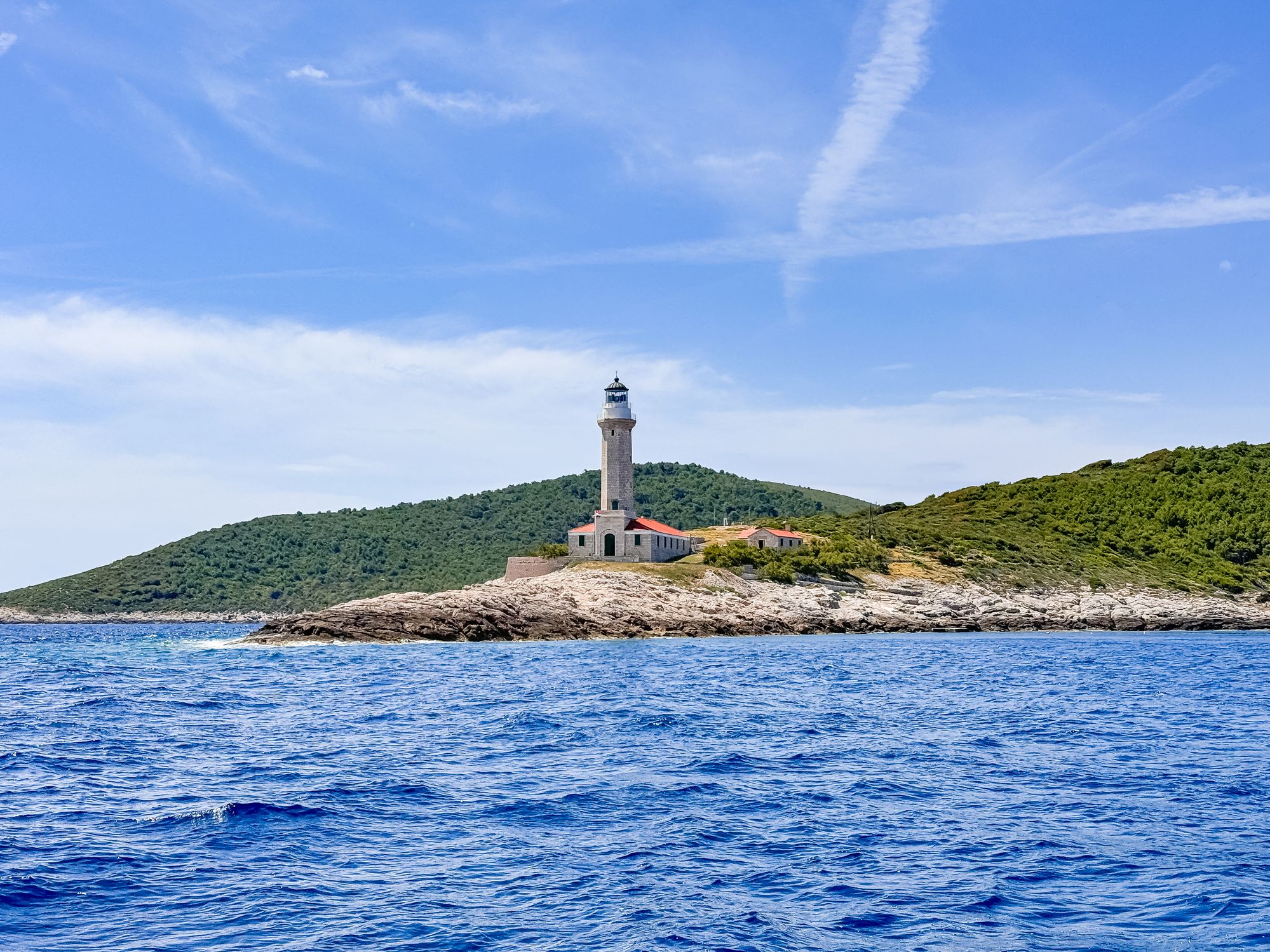
Protection: Stončica is extremely well protected from winds except for the Bora (strong NE wind). With high hills around, you’re safe from westerlies and southerlies here. But if a heavy NE Bora is forecast, Stončica’s entrance faces that direction, so it can become dangerous – in such cases Vis town harbour would be a better refuge. In normal summer conditions, however, Stončica is tranquil.
Anchoring technique: The bay has a sandy bottom, about 6–7 m deep in mid-bay, but the sand layer can be thin in spots, so anchors might drag if not set well. Make sure to dig the anchor in firmly. It’s common practice to drop anchor in ~5–7 m and then take a stern line to shore in Stončica. This secures your boat from swinging and also lets more boats share the cove. The recommended area is the south side of the bay (left side as you enter), where depths of 5–15 m and sand patches make for the best holding. Once you’re set, you can swim or dinghy further in – at the head of the bay is a small sandy beach with Konoba Stončica, a quaint family-run restaurant under palm trees. They serve delicious grilled fish and peka dishes; it’s popular so sometimes reserve by phone if you plan to dine (Tel. +385 91 251 2262).
The water in Stončica bay is crystal clear, great for snorkelling around your boat. After a meal or in the morning, consider a short hike to the Stončica lighthouse on the point – it’s an active lighthouse and offers a beautiful panoramic view. Overall, Stončica is a favourite “quiet night” stop for those exploring Vis, offering a perfect mix of shelter, a bit of shore hospitality, and natural beauty. Just beware of the persistent local donkey who might bray from shore in the early morning – a true Vis island wake-up call!
High-Season Berth Prices for a 12 m Yacht in Croatia in 2025
Below is a comparison of overnight berth prices in peak season (July–August 2025) for a 12-metre (39 ft) monohull at various Croatian marinas, town quays, and mooring fields. All prices include VAT.
| Location & Type | High-Season Rate (12 m) | Water/Electricity Included? | Catamaran Surcharge | |
|---|---|---|---|---|
| ACI Marina Split | €152 per night | Yes (normal use) | +100% (double price) | |
| ACI Marina Trogir | €136 per night | Yes (normal use) | +100% (double price) | |
| ACI Marina Dubrovnik | €106 per night (Fri/Sat +30%) | Yes (metered water) | +100% (double price) | |
| Hvar Town Harbour (Town Quay) | ~€96 per night (≈€8.0/m) | Yes (water & power supply) | +100% (double price) | |
| Stari Grad, Hvar (Town Quay) | ~€60 per night (≈€5.0/m) | Yes (water & power supply) | +100% (double price) | |
| Kaprije (Mooring Buoys) | ~€45 per night (buoy) | No (services not available on buoy) | +50–100% (varies by operator, cash only) | |
| Marina Frapa Rogoznica (Private) | €127 per night | Yes (water & 16 A power) | +80% |
Tips for mooring in Croatia in 2025
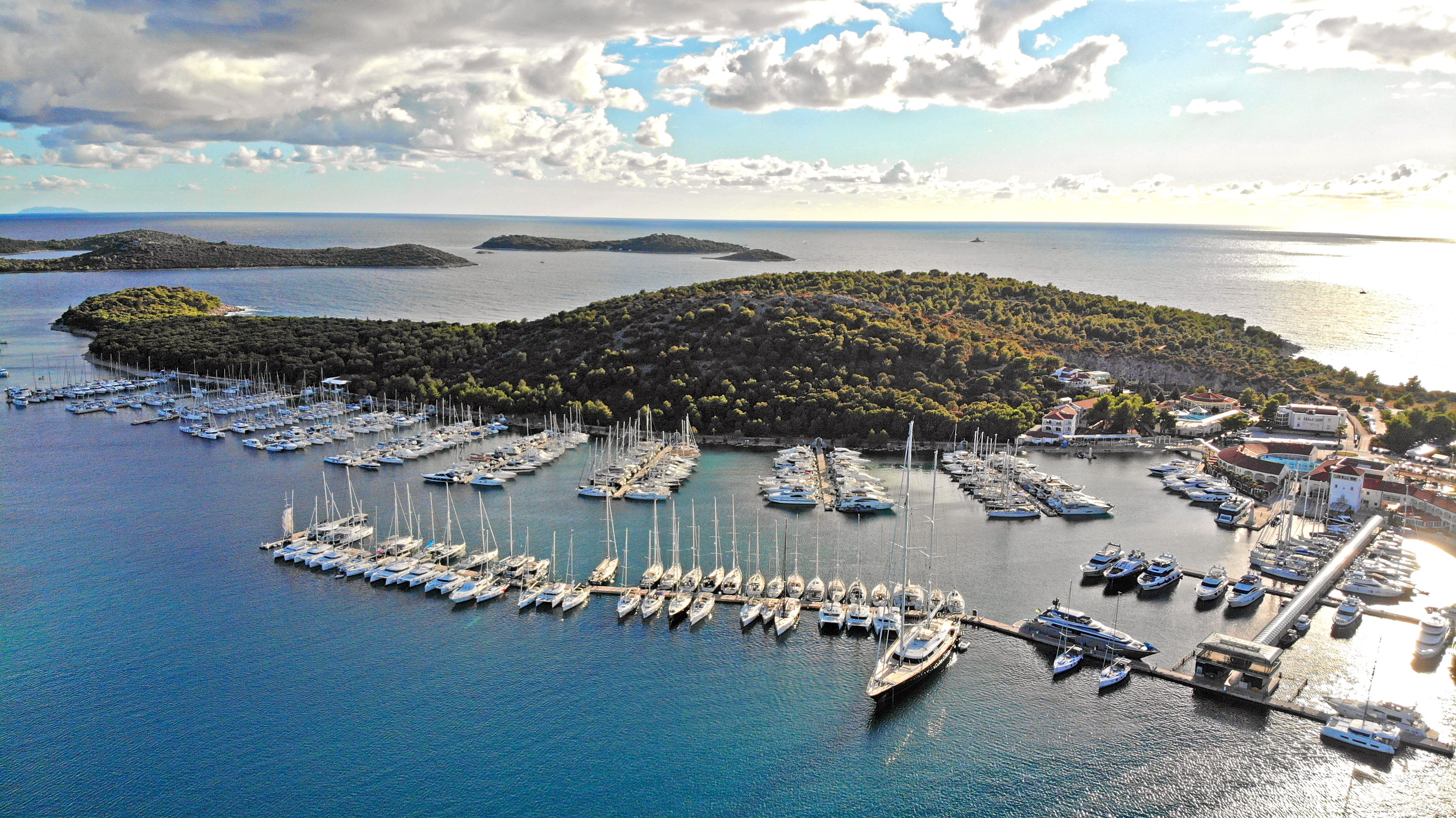
In peak season, expect the highest prices and fullest marinas. Plan a flexible itinerary – if Hvar Town quay is full (common by afternoon in summer), have a Plan B (such as the ACI Palmižana marina nearby, or an anchorage). Use VHF or phone ahead to check availability. Note that anchoring outside harbour limits is free (except within protected areas), but dropping anchor in popular bays may be regulated or subject to local concession mooring fields. Always verify whether an anchorage has a fee; legally, any charged mooring should come with an official price list and receipt. By understanding the fee structure – seasonal rates, surcharges, and park rules – you can better manage your cruising budget and even save money while sailing the beautiful Croatian coast.
- Electricity/water at town quays and buoy fields is usually an add-on (€5–15), whereas ACI daily rates already include “normal” consumption.
- Park vs. buoy fees: Kornati and Telašćica sell combination tickets that cover both parks for three days and can save 25–30 % if you plan to roam. You can buy it here.
- “Konoba-ticket” hack: some Kornati family restaurants issue discounted park tickets (pay ~€40 for the boat rather than €95) if you book dinner.
- Buy Kornati & Telašćica tickets online (mySea or Parkovi Hrvatske) one day ahead—prices jump ~20 % if a ranger sells you the ticket on arrival.
- Reservation apps: mySea & the ACI app give small discounts (5–10 %) and, more importantly, guarantee the berth in July-August.
Prices for Food and Provisioning in Croatia 2025
Groceries in Croatia are priced near the European average. After Croatia’s switch to the euro, there was a modest uptick in prices, and food inflation in early 2025 has been around 4 – 5 %. You can still provision quite reasonably if you shop at big supermarkets on the mainland (Konzum, Tommy, Lidl, etc.).
For a rough idea: a loaf of fresh bread might be €1.50, a litre of local milk €1, domestic wine €5–8 a bottle, and a kilo of oranges or tomatoes around €2–3 (depending on season). Local open-air markets in towns like Split, Zadar, or Dubrovnik are fantastic for fresh produce and also often cheaper than mini-marts on the islands.
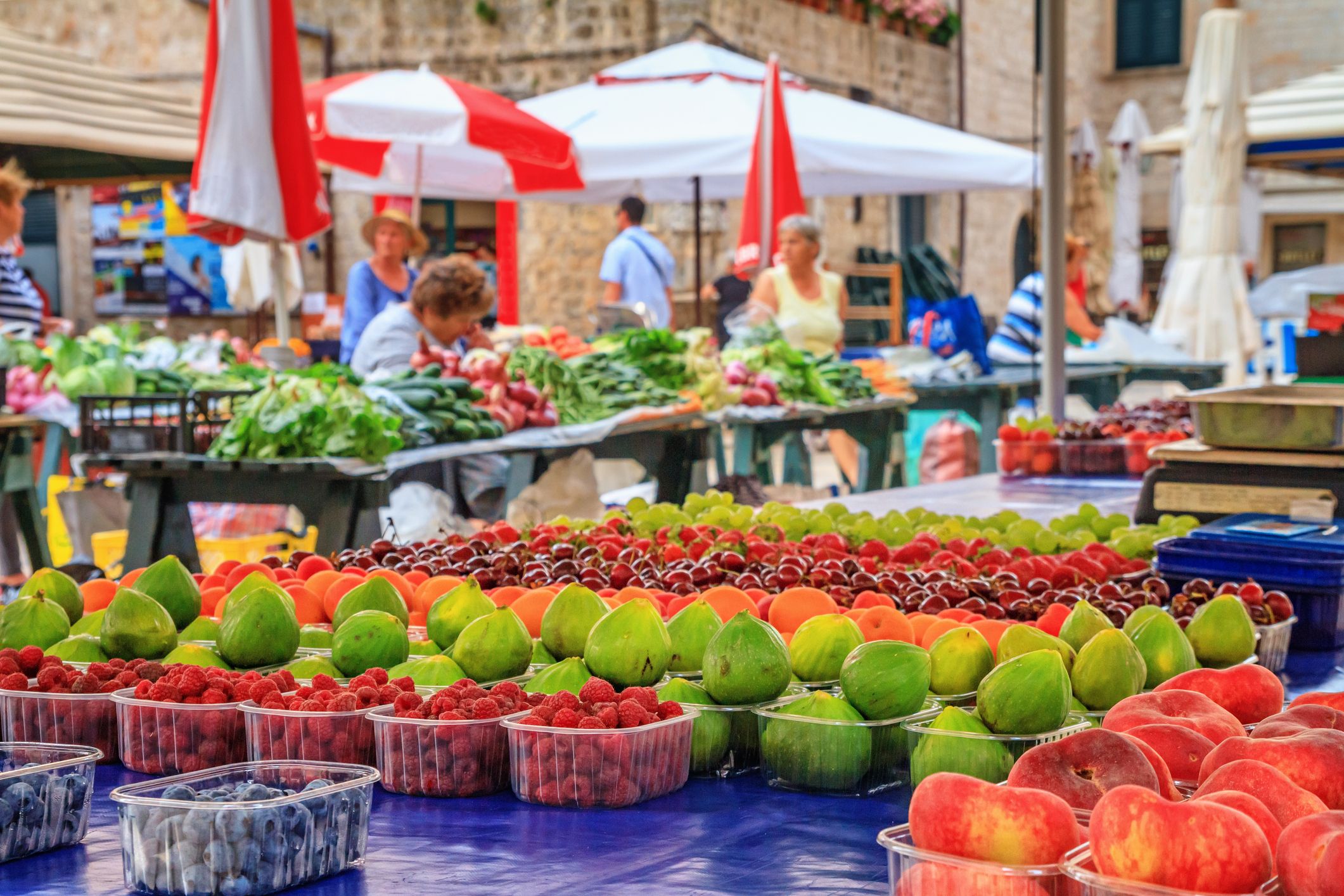
Island vs. Mainland prices: Be aware that on smaller islands (especially where goods arrive by ferry) you’ll pay a bit more – it’s wise to stock up on heavy items (water, drinks, bulk groceries) before you leave your departure marina. Remote bays with a lone restaurant or little shop might have notably higher prices for basics due to the transport costs.
Dining Out: Enjoying Croatia’s cuisine is a highlight of any sailing trip! Budget around €15–25 per person for a decent meal at a konoba (tavern) – for example, a plate of grilled calamari might be ~€15, a pasta ~€12, and a beer ~€3. In tourist-heavy spots (Hvar town, Korčula town, Dubrovnik) or upscale marina restaurants, entrees can jump to €25–40.
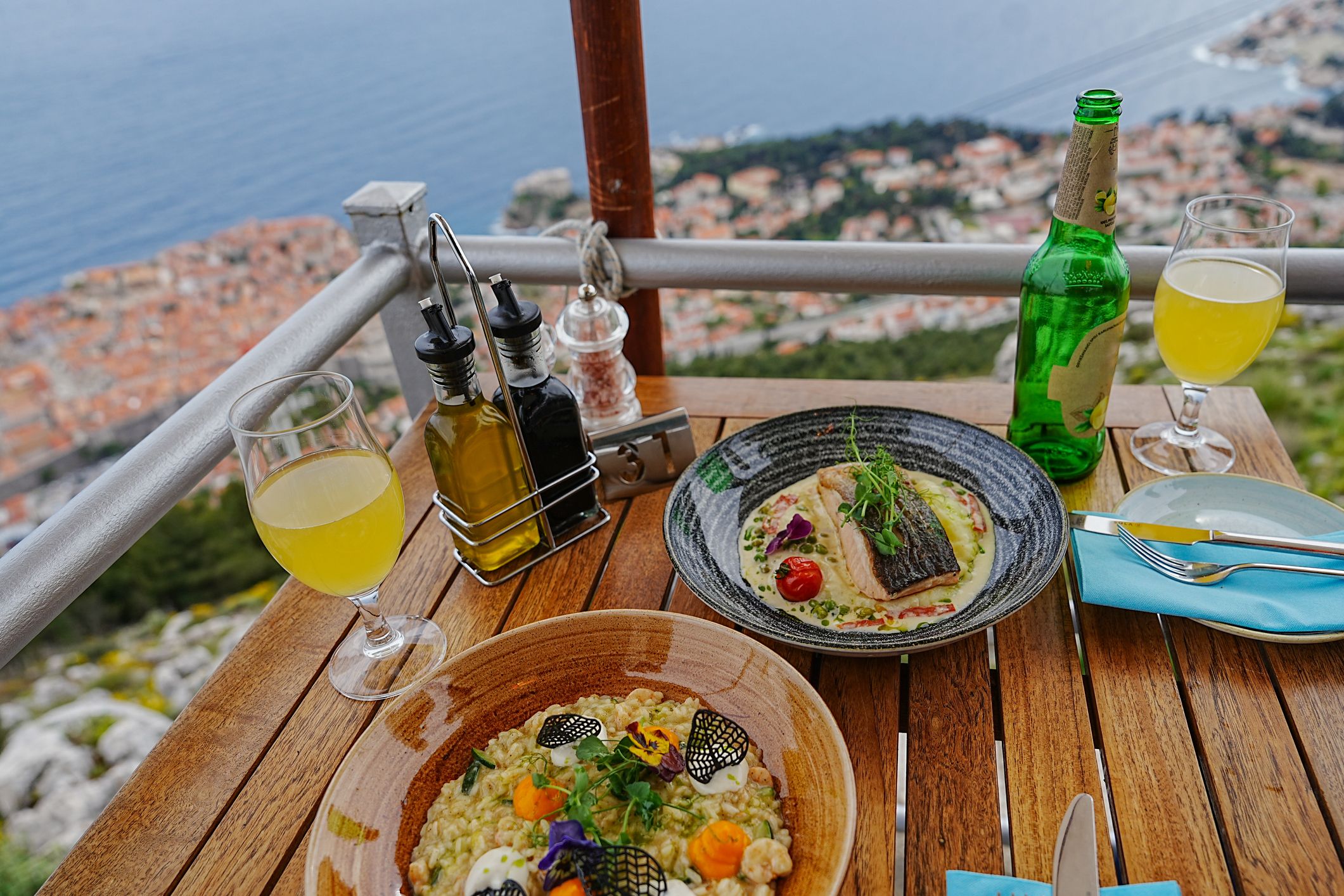
The good news is that many restaurants in secluded bays offer free mooring if you dine with them – a great way to combine a pleasant evening out with a safe berth for the night. And don’t miss stocking up on local delicacies: fresh bread from a village bakery, Paški sir (Pag island sheep cheese), olive oil, and local wine – živjeli! (cheers) to a well-provisioned voyage.
Croatia’s Top Sailing Regions
Croatia’s coastline is often divided into several sailing regions, each with its own character and attractions. Here’s a quick overview of the most popular regions sailors explore:
Istria & Kvarner (North Adriatic)
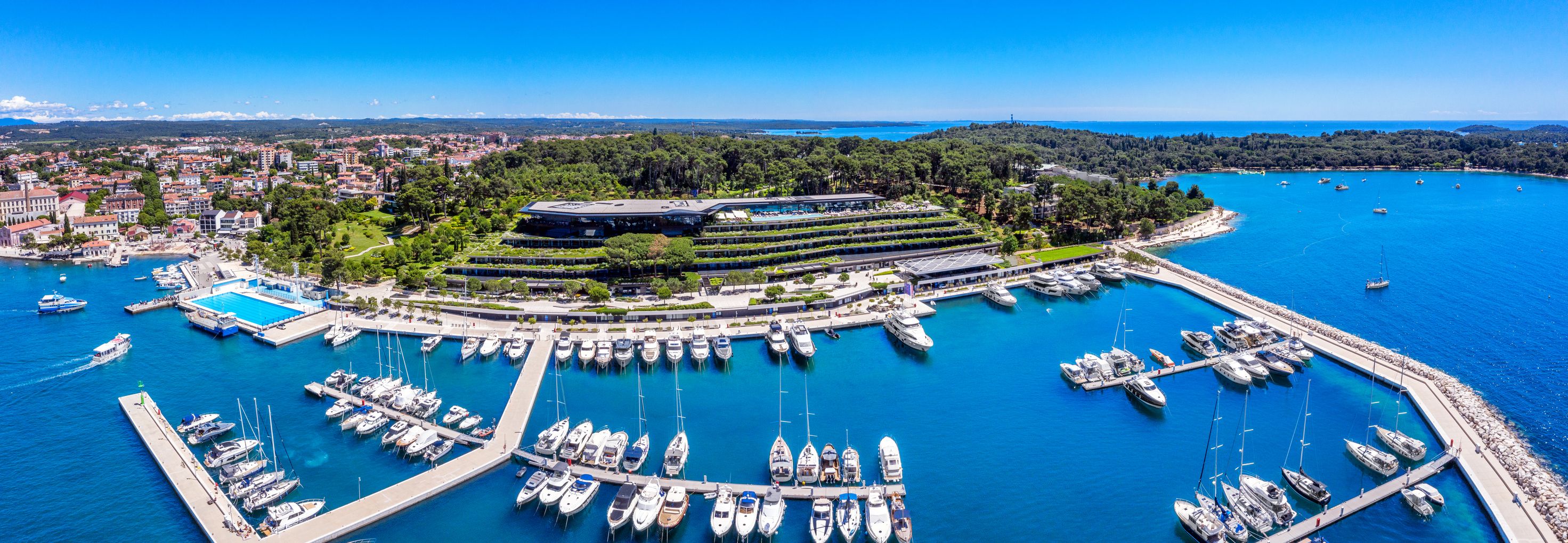
The northernmost part of Croatia offers a mix of historic coastal towns and quiet islands. Istria’s highlights include Pula (with its Roman amphitheatre) and Rovinj (a charming Venetian-style old town). Just offshore lie the Brijuni Islands (a national park with lush nature and even a safari park). Moving east into Kvarner Bay, you’ll encounter the large islands of Cres, Lošinj, Krk, and Rab. These islands feature secluded coves, gentle waters, and old villages like Mali Lošinj and Rab Town that welcome sailors. The Istria/Kvarner region is less crowded than Dalmatia, has slightly cooler water, and often gentler winds – perfect for a more relaxed sailing escape or for building experience. Don’t miss Cres’s Blue Cave or a stop in Opatija on the mainland (a classy 19th-century resort town).

Orizzonti Andromeda | Andromeda

Beneteau First 35 | Kalypso

Bavaria 30 Cruiser | La Luna
North Dalmatia (Zadar & Kornati)
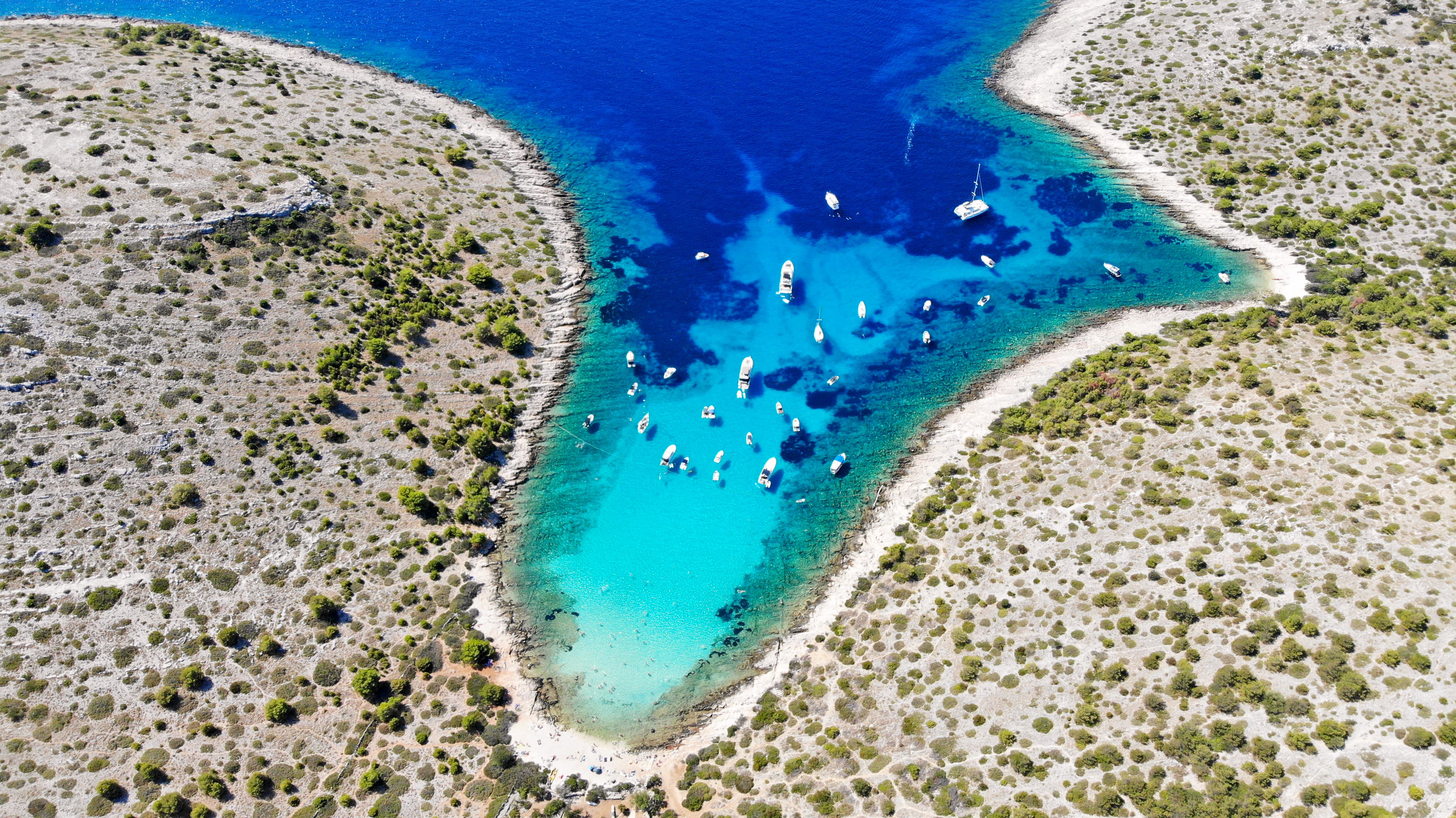
This region is known for its stunning archipelagos and national parks. The vibrant city of Zadar makes a great jumping-off point – be sure to experience Zadar’s waterfront “Sea Organ” and sunset views. Just south of Zadar lies the Šibenik archipelago and the Kornati National Park – a maze of 140 uninhabited islands famed for their otherworldly, barren landscapes and countless quiet bays. Sailing the Kornati is like being on another planet of rocks and sea, with simple family-run konobas in lonely bays serving super-fresh seafood. Nearby, Telašćica Nature Park (on Dugi Otok) offers a dramatic saltwater lake and high cliffs. North Dalmatia provides steady summer winds (often a NW sea breeze) and is ideal for those seeking natural beauty: think clear starry nights at anchor and morning swims in turquoise coves.

Bavaria Cruiser 36 | White Pearl

Bavaria Cruiser 36 | Estela

Adria 500 | 1
Central Dalmatia (Split, Hvar, Vis & Surroundings)

Central Dalmatia is the bustling heart of Croatia’s sailing scene, thanks to the Split Airport and many charter bases around Split, Trogir, and Šibenik. Within easy reach are the famous islands: Brač (don’t miss Zlatni Rat beach), Hvar (the glamour island with Hvar Town’s nightlife but also hidden bays like the Pakleni Islands), Vis (farther out, offering unspoiled charm and the Blue Cave on Biševo), and Šolta (a quieter island with lovely Maslinica harbour). This region perfectly balances lively ports and peaceful anchorages. One day you might be exploring Hvar’s historic town and dining in a top restaurant, the next day anchoring off Vis with just goats on shore.
Winds: the summer Maestral wind reliably blows from the NW most afternoons, providing great sailing; it dies down in the evening, keeping anchorages calm. Central Dalmatia can be crowded in high season, so it’s wise to start early to grab berths or use apps to reserve marina spots. Highlights include Brač’s tranquil bays, Hvar’s lavender fields (rent a scooter and tour inland), and perhaps a detour up to Krka Waterfalls (sail to Skradin and take a riverboat to stunning falls).

Jeanneau Sun Odyssey 440 | UwElli

Dufour 360 | Sileb

Dufour 350 | Sinica
South Dalmatia (Korčula, Dubrovnik & Mljet)
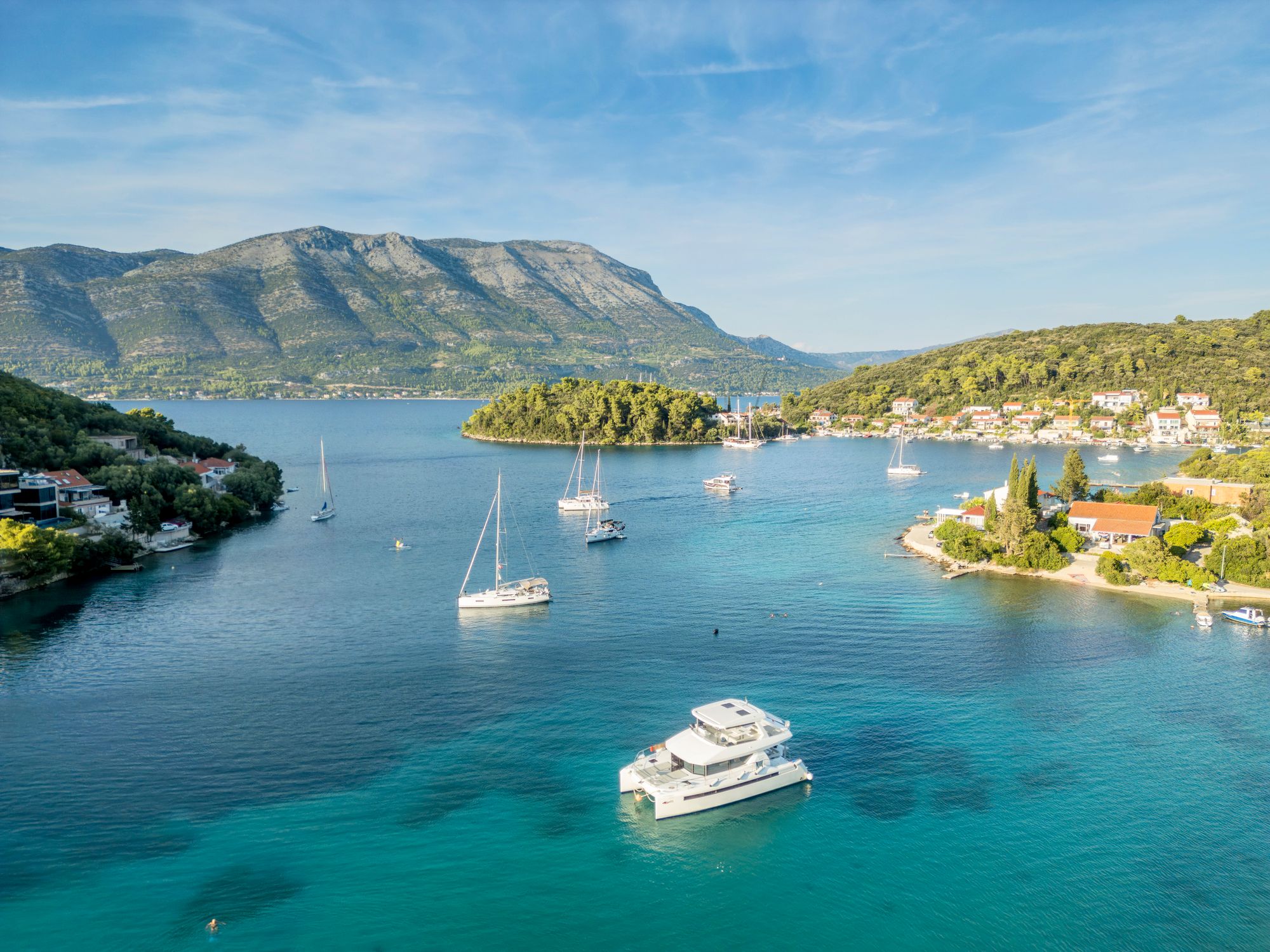
South Dalmatia encompasses the stretch from around Pelješac Peninsula down to Dubrovnik. It’s slightly more off the beaten path for sailors (except Dubrovnik itself, which is a huge attraction). Don’t miss Korčula Island, often called “Little Dubrovnik” for its walled medieval Korčula Town – reputed birthplace of Marco Polo. The channel between Korčula and Pelješac has some of the best wind in Croatia (popular with windsurfers near Viganj) and provides exhilarating sailing. Mljet Island is a gem – half the island is a national park covered in pine forests and lakes; Pomena and Polače are two harbours where you can moor and cycle to see Mljet’s famous salt lakes. Finally, the Dubrovnik area itself offers the Elaphiti Islands (like Šipan, Lopud, Koločep) – peaceful spots just a short sail from the bustle of Dubrovnik’s Old City. Dubrovnik’s marina (ACI Dubrovnik) is a common endpoint for one-way voyages, and spending a day or two walking the ancient city walls is highly recommended. South Dalmatia features slightly fewer yachts than central Dalmatia, strong summer winds at times (the Maestral and occasional afternoon gusts through channels), and incredible cultural sites. It’s perfect for the more adventurous itinerary or extending a one-week charter into a two-week one-way trip (e.g., Split to Dubrovnik).

Bavaria Cruiser 34 | Take Five

Pasara 440 | 10

Jeanneau Sun Odyssey 389 | Pitta
Each of these regions has its allure, and there’s no single “best” – it depends on whether you seek nightlife and social hubs, or tranquillity and nature, or a bit of both.
Plan Your Trip with Boataround
Make the most of your Croatian sailing holiday by tapping into two free knowledge banks on our blog:
🚩 Sailing Itineraries in Croatia
For day-by-day route ideas, browse the complete Boataround Travel Itineraries library – dozens of 7-day plans covering every corner of the Adriatic.
Check them out :)
-
7-day from Split – island-hop Brač, Hvar, Vis and Šolta.
-
7-day around Dubrovnik – Elaphiti Islands, Mljet NP and Korčula.
-
7-day from Trogir – mix lively marinas with quiet coves.
-
7-day from Pula – West Istria and Kvarner highlights.
Each outline lists daily legs, safe overnight stops, fuel and water points, and local restaurant tips, so you can copy-paste the parts you like into your log.
Tips from Us
Our Tips from Us section is packed with bite-sized advice written by sailors for sailors:
-
How to anchor like a pro – step-by-step technique plus skipper hacks for crowded Croatian bays.
-
First night sailing: preparation checklist – stay safe on your inaugural night passage.
-
Sailing trip essentials – what to pack – space-saving kit list for charter crews.
-
Smooth charter check-in guide – avoid nasty surprises at handover.
Fair winds and enjoy Croatia in the 2025 season!
This guide covered the essentials – new rules, secret anchorages, costs, regions, and resources – to help you sail smarter. Croatia’s Adriatic awaits with its crystal waters, historic ports, and warm hospitality. By staying informed and prepared, you’ll ensure a safe, enjoyable voyage. Remember: plan a bit, but also leave room for spontaneity. Sretan put! (Happy voyage!)


